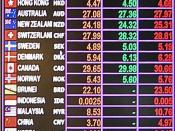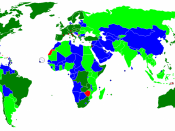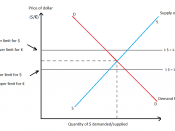Risk Management and the Foreign Exchange Market
2.1 Review of Foreign Exchange and Pricing Conventions
The price of one currency expressed in term of another currency, or put another way, the exchange rate is the rate of one currency in terms of another.
For example:
AUD/USD = .6230
which means that 1 Australian dollar will buy 62.30 US cents. In this example AUD is the commodity or unit currency, and USD is the terms currency. The commodity currency is written first followed by the terms currency. The two are separated by a slash and followed by the numeric rate.
2.1.1 Direct quotation
An exchange rate quote where the domestic or local currency is the terms currency . ie. 1 unit of USD equals x no. of units of local currency.
e.g. 1 USD = JPY 111.20
1 USD = EUR 1.7060
The direct quotation convention is used in the USA, Japan and Europe.
This has been a result of the emergence of the American dollar as the most-traded currency around the world. In practice, a direct quote means that the USD is the commodity currency in the quote.
2.1.2 Indirect quotation
Indirect quotation means that the foreign currency is the terms currency . The currencies of the former British empire countries (such as NZD,SGD,GBP and SGD among others are quoted as commodity currencies.
For example:
AUD/USD = 0.6230 - 35
SGD/USD = 0.6190 - 95
NZD/USD = 0.6170 - 75
GBP/USD = 1.2355 - 60
Some market jargon:
The above rates would be described in the markets thus - "the Aussie is sixty two thirty-thirty five" and the "Kiwi is seventy - seventy five" and the "Cable" is 1.2360 . USD is known as the "Dollar" or the "Big Dollar"`, depending on the country you are working in. In practice,


